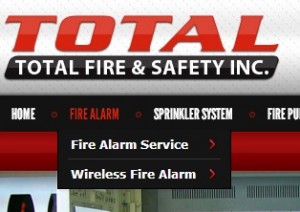-
December 4, 2018 by Total Fire and Safety

A brand new year is a great time for businesses to evaluate what they can improve upon, even in terms of their commercial fire safety. No business is completely immune to accidental fires and having the right equipment in place year round can prevent potential devastation.
According to the National Fire Protection Association (NFPA), more than 3,300 fires break out in office buildings across the U.S each year. The NFPA reports that a number of people are killed or injured with an estimated $112 million in property damage.
If you’re a business set on achieving your 2019 goal of reaching NFPA compliance, take a look at checklist of equipment you need below for commercial fire safety. Anything missing? Call Total Fire & Safety. We can help!
____ Alarms
____ Extinguishers and Suppression Systems
- Conduct tests regularly to ensure function and pressure when activated.
- Schedule routine maintenance of equipment.
- Store extinguishers in open areas for easy access.
____ Emergency Lighting
- Effective emergency lighting throughout the building will help occupants to safety in an emergency.
- Schedule regular maintenance and inspections.
Equipment is essential and necessary to prevent major damage but people are too! Whether it’s putting out a fire or tending to the injured, what good is the equipment if you don’t have employees able to use it?
____ First Aid
____ Training Courses
- A comprehensive fire equipment training course on the use of fire equipment and first aid can place confidence in employees and keep everyone safe.
- Training employees reduces the chance of small fires starting and spreading.
You could have all the equipment ready and employees trained to use it but they need something else.
____ Emergency Preparedness Plan
- Remind employees to REACT-(remove from danger, ensure doors/windows are closed, activate alarm, call 911, treat as dangerous.)
- Conduct fire drills.
- Schedule inspections of all fire equipment.
- Have employees trained on firefighting equipment.
Making sure you have commercial fire safety in place can seem a daunting task but the pros at Total Fire and Safety are here to simplify it. TFS covers everything including inspection, maintenance, training, and keeping your building up to code so you are well protected in the event of an unforeseen fire. Give us a call today at 630-960-5060.
Category: Business Safety, Fire Alarm Monitoring, Fire Equipment Inspections, Fire exits, Fire Extinguishers Tags: commercial fire protection, commercial fire safety, commercial first aid kit, emergency exit lights, emergency lighting, fire and safety solutions, Fire Extinguisher, fire safety, fire safety training, fireextinguisher, firesafetytraining, firesprinklerinspections, first aid | Comments Off on The Business Owner’s Checklist for Commercial Fire Safety in 2019
-
March 15, 2018 by Total Fire and Safety
 Nobody thinks much about emergency exit lights. But if the power suddenly goes out, smoke fills the room and you can’t see a foot in front of you, relying on the emergency lights may be your only means of escape. Nobody thinks much about emergency exit lights. But if the power suddenly goes out, smoke fills the room and you can’t see a foot in front of you, relying on the emergency lights may be your only means of escape.
Emergency exit lights are essential to safety in any dangerous situation. They can alarm someone in a fire, be the only source of light in the dark, and the key to safely exiting the building. Emergency exit lights are often overlooked and taken for granted, but take note of how many you come across every day. Do you realize how many requirements and regulations go into the installation and maintenance of one exit sign?
There are numerous agencies that govern emergency exit lighting and signs: OSHA (Occupational Safety and Health Administration), NFPA (National Fire Protection Administration, JCAHO (Joint Commission on Accreditation of Healthcare Organizations and the International Building Code and International Fire Code. Above all these agencies, the local authority is responsible for monitoring and enforcing building/fire codes.
According to OSHA, an exit route is defined as a continuous and unobstructed path of exit travel from any point within a workplace to a place of safety. There are three parts to an exit route:
- Exit access-part of the exit route that leads to an exit.
- Exit-part of the exit route that is separated from other areas and provides a safe means of travel to exit discharge.
- Exit discharge-part of the exit route that leads to directly outside or refuge area.
OSHA’s requirements for the lighting of these afore mentioned exit routes is covered under 1910.37(b). It states that each exit route must be sufficiently lighted so an employee with normal vision can see along the exit route and each exit must be clearly visible and marked by a sign reading “EXIT.” Additional information for OSHA requirements can be found at www.osha.gov.
The NFPA guidance for emergency exit lighting and signs can be found in the NFPA 101, Life Safety Code. The NFPA’s Life Safety Code provides information for placement, illumination, and visibility for exit signs.
- Placement of exit sign. Any exit signs must be located so that no point in an exit access area is more than the sign’s viewing distance, or 100 feet from the nearest sign.
- Visibility of exit signs-Every sign must be located and of such size, distinctive color and design that is visible and contrasts from the background of its placement. NFPA also states no decorations, furnishings, or equipment that impairs visibility of a sign shall be permitted. Nothing should be placed near an exit sign that distracts attention and inhibits visibility of an exit sign.
- Illumination of Exit Signs-The NFPA states all exit signs must be illuminated by a reliable light source and legible in normal and emergency exit lighting modes. There are two categories of illumination: external illumination, which comes from outside the exit sign and internal illumination, which comes from a source inside an exit sign.
According to the NFPA, emergency illumination must be provided for a minimum of 1.5 hours in the event of power outage. The emergency lighting must be illuminated not less than an average of one lumen per square foot. The maximum illumination at any point can be 40 times the minimum illumination. All emergency exit lighting must be able to provide lighting automatically when normal light is interrupted.
Many emergency exit lights are now using LED lights. The NFPA states that LED lights are longer lasting, provide better light and are most durable. In emergency situations, LED lights emit sufficient lighting and are most effective when placed properly. They are also most energy efficient, saving the building money.
According to the NFPA requirements for testing, there are three categories of emergency lights: traditional, self-testing, and computer base self-testing. A monthly activation test which involves having the lights illuminate for no less than 30 seconds and an annual test which keeps the lights illuminated for 1.5 hours, simulating a long-term emergency. Records of these test must be maintained for inspection.
Many regulations, codes, and considerations go into the signs and lights you see every day so it is important to have regular maintenance and testing of these lights. Total Fire and Safety has a knowledge team for inspecting emergency exit lighting. With regular maintenance and testing from Total Fire and Safety, you can be assured your emergency exit lighting is up to code and the safety of your employees/tenants is assured. Give us a call today 630-960-5060.
Category: Business Safety, Fire code violation, Fire Equipment Inspections, Fire exits, Fire News, Fire Safety, Health and Safety, LED Lighting, NFPA Compliance, Total Experience, Total Fire and Safety Tags: commercial fire protection, commercial fire safety, emergency exit lights, emergency lighting, fire and safety equipment, fire and safety needs, fire and safety solutions, fire safety in the news, fire safety solution, fire safety training, lifesafety, safety | Comments Off on Are You In the Dark About Emergency Exit Lights?
-
June 12, 2014 by Total Fire and Safety
 What kind of lights do you have in your emergency exit signs? Chances are, they are incandescent and fluorescent lights and probably have been for some time. Now, however, LED (light emitting diode) lighting is becoming a safer, more economical way for businesses to provide reliable, emergency lighting. Have you discovered how LED emergency lights can help your business? Here are the top ten reasons to consider it: What kind of lights do you have in your emergency exit signs? Chances are, they are incandescent and fluorescent lights and probably have been for some time. Now, however, LED (light emitting diode) lighting is becoming a safer, more economical way for businesses to provide reliable, emergency lighting. Have you discovered how LED emergency lights can help your business? Here are the top ten reasons to consider it:
LED COST SAVINGS
LEDs are notorious for saving the customer money. How much will you save making the switch to emergency LED lights? The answer depends upon your facility and number of LED emergency lights, but statistics show the savings could be dramatic. According to Energy Star, a qualified LED bulb has an average operating cost of $1 per year, while a compact florescent bulb’s annual cost is $1.20, $3.50 for a halogen incandescent bulb and $4.80 for a traditional incandescent bulb. In the case of exit lighting, where illumination is 24/7, significant savings always occur when our customers switch to LEDs!
EFFICIENCY One of the reasons LEDs are more affordable to operate is because the LEDs run at a lower temperature than incandescent. This increases the bulb’s efficiency because they generate more energy as light, not heat.
LED LIFESPAN LEDs are also known for their longevity. Since they don’t rely on a burning filament for light, they can last up to 50,000 hours or more! While annual maintenance is still required, our customers appreciate how infrequently LED lights need replacement.
BRIGHTNESS Over the years, the color and technology of LEDs has improved significantly. Today’s LEDs are pleasing to the eye and outshine regular bulbs dramatically. They can be seen from maximum distances, and are therefore perfect for providing illumination in times of emergency.
ADVANCING TECHNOLOGY LED lighting continues to improve and demand for LEDs is increasing. More and more options are becoming available for LED emergency lighting, from standard exit sign units to lighting strips that can be incorporated very subtly into the architectural elements of the buildings.
CONSTRUCTION LED lighting is thinner and lighter than other bulbs and therefore easier to install and maintain. Yet they are truly robust and offer some of the brightest lighting available. In fact, the construction of LED lights and absence of glass makes them the safest choice for mining, oil, exploration and other explosive environments.
RELIABILITY LEDs are easily controlled and since they use a minimum of power, they are ideal for operation from a backup generator or battery. When you need them, LED emergency lights are there.
ENVIRONMENTALLY FRIENDLY LEDs are considered environmentally friendly since they contain no lead or mercury. They also last longer than incandescent bulbs, which end up in landfills much sooner. LEDs are considered the “way of the future” and expected to decrease energy costs nationwide.
RESILIENCY LEDs are tough, and resistant to shock and vibration. They are therefore less likely to be damaged in public places.
SPACE EFFICIENCY LEDs are very focused, bringing illumination to designated areas. LEDs rely on their own dedicated optics, drivers and fittings, so they can be easily incorporated into different types of lighting fixtures using a minimum of space.
Still wondering if LED emergency lights are right for you? Contact Us Today for a free estimate on making the switch to LED emergency lighting.
Category: LED Lighting Tags: commercial fire protection, emergency exit lights, emergency lighting | Comments Off on 10 Reasons to Have LED Emergency Lights
-
May 21, 2014 by Total Fire and Safety
Total Fire & Safety is welcoming some new additions to our website, including the “Wireless Fire Alarm Monitoring” page!

More and more municipalities, particularly in Chicagoland, are looking to reduce costs and increase efficiency by mandating wireless fire alarm systems for the businesses in their service area. Wireless fire alarm monitoring is faster, safer, and more reliable than phone- based systems that can fail from environmental factors. Also, with wireless fire alarm systems, businesses can disconnect their unneeded landlines and realize a substantial monthly savings.
Our new page includes information about Vigilant™ fire alarm monitoring equipment, which is our preferred manufacturer of fire safety equipment. Vigilant is an industry leader known for its affordable, yet high-quality products that easily retrofit in single-unit facilities or multi-story office buildings.
We’ve also added new icons on our home page to signify three growing and very important parts of our business—life safety training, first aid supplies and emergency lighting.

A new icon on our home page indicates our established life safety code training service which prepares employees for fire scenarios and teaches them the correct use of fire safety equipment. For businesses where fire prevention is a priority, these classes prepare employees with the information they need to keep themselves, their co-workers, and the facility safe. Classes are held at your location in a classroom setting with a hands-on, live burn session so employees get firsthand experience in extinguishing a fire. Other classes we offer include: hood suppression systems, paint booth suppression systems, proper evacuation procedures, fire sprinkler systems proper apparatus usage and more.

Everyone knows the red cross means safety, and the recently added icon represents our first aid supplies. Our service protects your employees with stocked cabinets of quality first aid supplies that we routinely replenish. When a minor injury occurs, your business is prepared, with the the right supplies on hand. We make the program affordable by only charging for the products your employees use. Our service helps businesses meet OSHA Regulation CFR 1910.151 (b).

Our third new home page icon is the exit sign, which represents our emergency lighting and LED emergency lighting, including signs and combination exit sign and lighting units. We keep your emergency lighting in working order with regular inspections to ensure that all units are in compliance, mounted correctly and free of damage, with batteries charged and bulbs in proper working order. We are also specialists in helping companies convert their emergency signage from conventional light bulbs to LEDs, which has helped many of our clients reduce their service and supply cost.
We regularly provide free evaluations of your existing systems and can make recommendations on how to reduce costs for your company. For more information on our quality products and services, or to schedule an evaluation of your site, visit us at totalfireandsafety.com or call us at 630-960-5060.
Category: Fire Alarm Monitoring, Total Fire and Safety Tags: emergency lighting, fire and safety equipment, fire and safety needs, first aid supplies, life safety training, lifesafety, wireless fire alarm monitoring, wireless fire alarms, wireless fire alarms for business | Comments Off on Announcing….Our New Wireless Fire Alarm Monitoring Page!
|

|
|
|
|
|
|

 Facebook
Facebook
 Instagram
Instagram
 LinkedIn
LinkedIn
 Nobody thinks much about
Nobody thinks much about 



